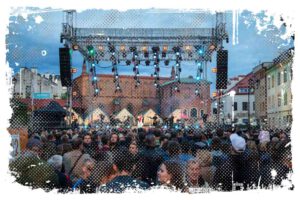Let me tell you that, if you were to venture to Krakow, there’s a place you’d definitely want to know about – the Eagle Pharmacy Museum. Back in the early 1900s, it stood in a district called Pogórze, that was eventually swallowed by the city. You’d find it quite fascinating that the only non-Jewish resident in the Jewish ghetto was the one who owned this pharmacy.
Eagle Pharmacy – Very Different
You might be picturing a regular pharmacy, right? But let me tell you now, it was so much more than that. Not only could people pick up their medications, but it also became a beacon of aid, providing supplies, and even contact for the Jewish people in the ghetto.
Fast forward to today, the Eagle Pharmacy wears another hat. It’s a part of the Krakow Museum, and it showcases the original interiors of the pharmacy managed by Tadeusz Pankiewicz. It’s worth to say that this man played a significant role for the Jewish community in Krakow.

Now, if you need a glimpse into history, walk through the rooms of the pharmacy. You’ll discover the people connected to it and trace the wartime stories of Krakow’s Jewish residents.
↳ Make sure to read my guide to the most amazing places to stay in Kraków:
How to Find Best Place to Stay in Krakow Old Town – Your Guide
Inside the Eagle Pharmacy in Kraków
Once inside, you’d see most of the furniture and vessels that were used in the pharmacy, faithfully reconstructed. Accompanied by period objects, it will give you a deep insight into the daily hustle of a pharmacist at the start of the 1900s.
To enhance the experience, the exhibition features films, photos, multimedia presentations, and a plethora of documents. I can tell you’d be captivated by the memoirs of Tadeusz Pankiewicz about the ghetto and the Holocaust.

The Origins of the Eagle Pharmacy
Imagine a time almost a century ago. The Eagle Pharmacy, known then as the Pod Orłem Pharmacy, situated at 18 Bohaterów Getta Square (formerly the Small Market Square, then Zgoda Square), had been serving the people since 1909. It was first owned by Józef Pankiewicz, and later, his son Tadeusz took over from 1933.
In the early days, this pharmacy served both the Jewish and Polish residents of the Podgórze district. I think it’s interesting to note that their medicines were supplied by a charitable organization called Bikkur Cholim.

Now, here’s where the story takes a turn. It was March 1941 when the Germans set up a ghetto for Krakow’s Jewish residents right in Podgórze. The Pod Orłem Pharmacy at Zgoda Square ended up being the only pharmacy within it, and Pankiewicz, its owner, was the only non-Jewish person allowed to stay there permanently. I am convinced this was no ordinary place – it became a gathering point for Jewish intellectuals, scientists, and artists.
Pharmacy as a Lifeline
Soon, the pharmacy began dispensing various resources and medicines that helped the ghetto inhabitants avoid deportation. From hair dye used to look younger to a tranquilizer called luminal for calming children hidden in secret places or being smuggled out, it played a pivotal role. Being there, you need to know, this pharmacy was more than just a dispensary. It was a lifeline.
You need to know that in the grim year of 1942, when bloodshed marked Zgoda Square, the Eagle Pharmacy and its staff offered a glimmer of hope. They handed out medicines and bandages for free to those wounded. The hidden corners of the pharmacy served as secret storage, stowing away items that could possibly save lives from death camp deportations.

Pankiewicz and his team – Irena Droździkowska, Aurelia Danek, and Helena Krywaniuk – played a crucial role. They acted as the bridge between the Jews in the ghetto and the outside world. Apart from relaying information and sneaking in food, they safeguarded precious items entrusted to them by deportees just before they left the ghetto.
A Safe Haven Amidst Chaos
The pharmacy became a haven, providing shelter during the deportations, and passing messages or packages in and out of the ghetto. I think it is worth saying that being non-Jews, Pankiewicz and his team had more rights. Most notably, they could leave the ghetto, which let them bring in news from Krakow and maintain contact with the world beyond the walls.
Remember, these privileges hung on the whims of the Germans. If they ever discovered the pharmacy’s double dealings, the staff faced severe punishment – even death. For their brave acts, Pankiewicz was honored with the title of Righteous Among the Nations.

A Cultural Hub Amidst Despair
Believe it or not, the pharmacy was also a cultural hub for Jewish intellectuals trapped in the ghetto. Here they could engage in discussions, and even sneak a peek at underground newspapers.
Moreover, the pharmacists continued to support the needy Jews, dispensing various medicines for free. This included sedatives, luminal (which kept children silent when hiding), and hair dye (used to make people look younger and fit for work, in the eyes of the Germans).
My Pharmacy Experience – Journey Back in Time
If you want a personal touch to this story, I’ll share my experience with you. Stepping inside the pharmacy, I was greeted by a newspaper over 70 years old, still hanging by the door. Beyond the entrance, I saw hundreds of pharmacy containers and a beautifully adorned pharmaceutical cabinet – full of drawers, large and small, complemented by a counter.

I almost forgot that just outside, everyday life continued at Ghetto Heroes Square. It felt as though a cheerful Tadeusz Pankiewicz would pop out any moment and ask what ails me.
This man, the owner of the pharmacy, found his business unexpectedly in the ghetto during the German occupation. He could’ve chosen a quiet life, shut his business down, or moved elsewhere. But, I am convinced, he courageously chose to stay at today’s Ghetto Heroes Square, disregarding the surrounding turmoil.

His staff followed suit, using the pharmacy as a front while they aided the persecuted Jews. The Pod Orłem Pharmacy became a place for information exchange, package transfers, meetings, and many found shelter here.
Stepping Back in Time
Being there, you need to know that an interactive exhibit sweeps you through the history of this pharmacy. It feels somewhat like a wing of Schindler’s Factory. The museum isn’t large, and you can take in everything in detail pretty quickly. Now that you’ve been introduced to Pankiewicz and his crew, you can advance to the second room. What catches your eye there are yellowed prescriptions – not your usual medical recipes, but lifelines for surviving in the ghetto.
Moving a few steps into the next room, you find a sturdy desk. The presence of the pharmacy’s proprietor seems to linger there, with two more rooms awaiting exploration.
Your tether to the 21st century? That would be the electronic screens lining the walls, streaming letters and memories of Jews from the ghetto, even those of small children. Through the windows, the hustle and bustle of the street unfodls – but it’s not today’s street life.

Thanks to multimedia projectors replacing the glass, you witness Krakow in the 1940s. Around you, an array of additional materials – videos, photos, screens – enriches the astonishing impression made by the pharmacy’s interior.
The final two rooms offer less tangible experiences. In one, you encounter the pharmacy as a meeting place. In the other, you explore the post-war attitude towards Jews in Poland – who remembered them and, if anyone, who did not.
The last room poses a question, leaving room for reflection, rather than providing an answer.
An Authentic Memory Laboratory
I think it is worth saying that what makes this place extraordinary is its authenticity. The museum is a near-perfect reproduction of Pankiewicz’s establishment. Although many original items were lost, the adept staff of the Historical Museum of the City of Krakow recreated them impeccably.
If you need a visual, picture the pharmacy brimming with medicine boxes, pamphlets, and herbs. Maps, documents, and photographs also draw the eye. The abundance of information means you could easily miss something, so a thorough exploration is a must. You have to open drawers, peer into cabinets, and dig around.
While the space might not impress those seeking vast expanses, it will certainly captivate those who appreciate places like Schindler’s Factory.

Even though it shares similarities with Schindler’s Factory, it is unique. Following a comprehensive renovation last year, the branch of the Historical Museum of the City of Krakow now features a thoughtful and unobtrusive use of modern technology. The Eagle Pharmacy truly is a time machine and a memory lab. I believe it’s worth a visit.
Chronicling the Past
Gazing out the windows onto Zgoda Square, Pankiewicz watched as it served as the meeting ground for the Germans at each deportation. He observed German actions and the reactions of both sides, being an eyewitness to scenes many would rather not see. He recorded these events in his book „Pharmacy in the Krakow Ghetto„. If you want to deepen your understanding of this pharmacy’s past, this book makes a wonderful companion to your visit.
In his writing, Pankiewicz paints a picture of his guests and friends who frequented the pharmacy, and reveals the fluctuating moods within the ghetto. It’s a study of how hope persisted in the hearts of the ghetto residents till the end, the resilience of life under hopeles conditions, and the range of human responses to extreme situations.
„Pharmacy in the Krakow Ghetto” stands as a testament to the memory of both victims and perpetrators. It allows you to better grasp abstract terms like „ghetto” or „deportation” by telling their individual stories. It is worth to say, Pankiewicz doesn’t shy away from detailing the human reflexes of Nazi officers or the motivations of Jews who collaborated with their tormentors.

The book offers a timeless lesson – history is seldom black and white. To judge individual actions, one must understand all the circumstances, a task that can be difficult even for an eyewitness like Pankiewicz.
Sightseeing in a Nutshell
Here are some of the things you need to know about your visit:
Advantages:
- Intuitive exploration
- Fair pricing
- High interactivity
- An authentic, thoughtfully curated exhibit
- Ability to visit on a combined ticket with Schindler’s Factory or Pomeranian
Disadvantages:
- Limited space, so it might feel crowded with just a dozen visitors
- The visit might not take much time
- Often crowded with tourist groups
Estimated visit duration: 20 minutes for a quick look, 30-40 minutes for an average visit, and up to 1.5 hours for a detailed tour.
The most intriguing exhibits include children’s letters, herbs, and medicine packaging.
Ticket prices in 2023:
- Normal ticket – 18 PLN
- Reduced ticket – 14 PLN
- Group ticket, school ticket – 12 PLN
- Family ticket (2 adults and 2 children up to 16 years old or 1 adult and 3 children up to 16 years old) – 20 PLN
- Audioguide rental – 14 PLN
- Free Entrance: Every Wednesday! (for more thing to do for free in Krakow read this)
- Prices are subject to change – check the lates prices on their website
References:
- https://www.facebook.com/AptekaPodOrlemMuzeumKrakowa/
- https://karnet.krakowculture.pl/19-krakow-apteka-pod-orlem
- https://pl.wikipedia.org/wiki/Apteka_Pod_Or%C5%82em_w_Krakowie
- https://muzeumkrakowa.pl/oddzialy/apteka-pod-orlem




